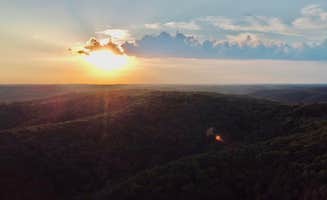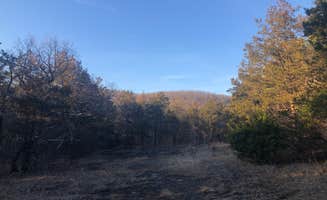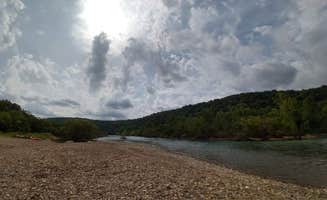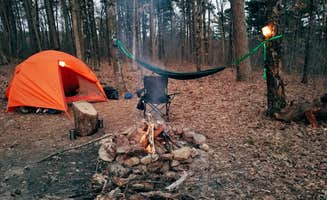Dispersed camping near Blue Eye, Missouri centers around the Mark Twain National Forest, which covers 1.5 million acres across southern Missouri. The area features oak-hickory forest ecosystems with elevations ranging from 600 to 1,400 feet. Spring and fall offer moderate temperatures in the 50-70°F range, while summer months can reach 90°F with high humidity.
What to do
Hiking exploration: The Hercules Glades Wilderness Area offers several trail systems with varying difficulty levels. "This is a short four mile hike into cool shut ins that provide a swimming hole and water falls. Along the way on the ridge you can see all the way down into Arkansas," notes one visitor. Multiple established trails provide access to diverse terrain and scenery.
Water activities: The Buffalo River area near Woolum Dispersed Area provides swimming and paddling opportunities during warmer months. A camper observed, "Right on the river with both a rock and sand beach currently." River levels fluctuate seasonally, with spring typically offering the best conditions for water activities.
Rock climbing: For those willing to drive slightly farther, experienced climbers can access numerous routes. "This facility has day-use for rock climbing. Motorcycle friendly but there is a sign stating no OHV's," explains one reviewer about nearby climbing opportunities.
What campers like
Solitude and quiet: Many campers appreciate the remote nature of dispersed sites around Blue Eye. At Blair Ridge Rd Dispersed, visitors noted, "There are two fire rings along this road. Both locations have full bars (Verizon). Little to no man made noise but be respectful, there is a private residence at the end of the road."
Wildlife viewing: The forest areas support diverse wildlife populations. Campers report deer sightings at multiple locations, with one noting, "Bambi and her mom also seem to live here." Bird watching opportunities are abundant throughout the region, particularly during spring and fall migration periods.
Night sky viewing: The minimal light pollution in dispersed camping areas creates excellent stargazing conditions. A camper mentioned that "On the right dark night you can see every star in the sky," highlighting the astronomical viewing opportunities in the region.
What you should know
Access road challenges: Many dispersed sites require navigating unpaved forest roads. At Sugar Camp Lookout Tower Dispersed Area, a camper noted, "Access road was a little rough, as in your typical dirt road, but posed 0 problems for our little economy car. I've had much worse for sure."
Limited amenities: Pack accordingly for primitive conditions. "This is a very primitive campground, but it's one of our favorites! We can almost always find a spot to camp and it's super easy to pull our trailer into every spot there," explains a reviewer about one area. Most dispersed sites have no water sources, requiring visitors to bring sufficient supplies.
Seasonal considerations: Tick activity peaks during warmer months. Weather can change rapidly, particularly during spring and fall. Summer humidity can be challenging, while winter camping requires proper cold-weather gear due to temperatures regularly dropping below freezing.
Tips for camping with families
Site selection: Choose established sites with level terrain for easier tent setup. At Hercules Glades (Watch Tower), a visitor noted, "Sites included a metal fire ring and table; some with tent pads. Hammock camping is possible depending on the site."
Wildlife education: Turn wildlife encounters into learning opportunities for children. Bring field guides to identify local plants and animals. Teach proper food storage techniques to minimize wildlife interactions around your campsite.
Recreation planning: Plan day trips to nearby conservation areas. Schedule hikes during cooler morning hours when visiting during summer. Bring games and activities suitable for campsite play during downtime.
Tips from RVers
Vehicle limitations: Many forest service roads have size constraints. At Pine Hollow 1045 Dispersed Camping, a reviewer advised, "Don't recommend bringing anything to large down the road camper van would be fine but would be difficult with a full size rig or towing anything much larger than a pop up."
Limited turnaround space: Scout sites before attempting to park larger vehicles. Consider stopping at ranger stations for current road condition information. Some sites require backing in with limited maneuvering room.
Self-contained requirements: Bring sufficient water supplies for your entire stay. Utilize composting toilets or pack-out waste systems for extended stays. Plan for no hookups or dump stations at dispersed sites near Blue Eye.





